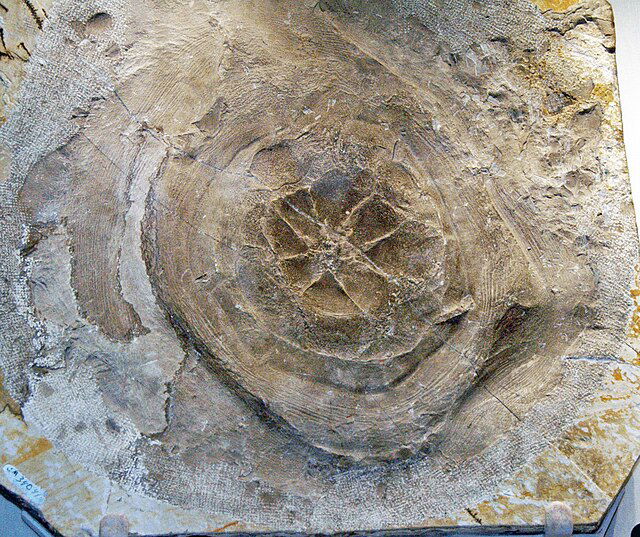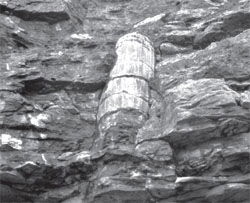
Chapter 9
Do Fossils Show Signs of Rapid Burial?
Is uniformitarianism really a true understanding of the rock and fossil records?
Uniformitarianism (or gradualism) is the secular belief that rock layers were laid down slowly over millions of years. This view was prominently taught by Charles Lyell through much of the 19th century and strongly influenced Charles Darwin, as well as much of modern geology.
But is uniformitarianism really a true understanding of the rock and fossil records? Did it really take long ages to lay down all these rock layers? Today, that view is being seriously questioned, and rightfully so! Consider a modern geology professor’s comments:
Furthermore, much of Lyell’s uniformitarianism, specifically his ideas on identity of ancient and modern causes, gradualism, and constancy of rate, has been explicitly refuted by the definitive modern sources, as well as by an overwhelming preponderance of evidence that, as substantive theories, his ideas on these matters were simply wrong.1
When we look at the geologic record in light of the Bible, however, a whole new way of understanding the formation of rock layers and their contained fossils opens up. Earth history as described in the Bible was dominated by several great, world-changing events. First, the earth resulted totally from the six-day creation event (Genesis 1). It was subsequently altered by the Curse on all creation due to Adam’s rebellion (Genesis 3). This was soon followed by the great Flood of Noah’s day (Genesis 6–9). The Flood is described as nothing less than a tectonic and hydraulic restructuring of the planet, particularly its surface layers. No place on earth escaped its terror. All land-dwelling, air-breathing life not on the ark was drowned by the Flood waters (Genesis 7:22).
What Would a Major, Catastrophic, Global Flood Do?
A global Flood would have done what major floods do. Such a Flood would have eroded and dissolved both soil and rock. Fragments would have been transported and redeposited elsewhere as sediments full of dead plants and animals, the creatures that died in Noah’s Flood. Now we observe those sediments hardened into sedimentary rock layers, while the dead things have hardened into fossils.
We can be certain the great majority of earth’s sedimentary rock layers and their contained fossils are the result of that great Flood. Evolutionists often wrongly use rocks and fossils to support long ages of evolutionary change, but since Noah’s Flood really occurred, it must have laid down the rock layers and fossils. Take rocks and fossils away from evolutionists and evolution’s story, and they have no evidence remaining!
Don’t think of the Flood as a time when things were merely carried along and then settled out of moving water. Rather, the sediments were deposited in dynamic episodes, one following the other until thick sequences of layers had accumulated, triggered by a combination of consecutive tidal waves (tsunamis), tides, pulses of gravity-driven underwater mud flows, and other processes. The whole sediment package amassed quickly, within the Flood year, not over the hundreds of millions of years claimed by evolutionists. The fossils are evidence of this rapid accumulation.
The conventional secular idea about sediment and fossil deposition involves long ages of slow and gradual accumulation in calm and placid seas. However, fossils are almost never found today in the sea. Life abounds in the sea, but fossils of sea creatures do not. Fossils are hardly ever preserved in an oceanic context. Great deposits of fossils are found in marine sediments, but always on the land! They show evidence of dynamic marine forces destroying life on the continents. What can we make of the myriads of marine fossils found in Kansas, but none in the south Pacific?
How to Make a Fossil
An oft-repeated series of textbook illustrations shows a hypothetical animal dying alongside a stream. Before nature’s degradative influences have full sway, the stream overflows, burying the carcass in mud, protecting it from ruin. Over the years, the mud accumulates around the remains, and eventually the entire region subsides, allowing even greater thicknesses of lake bottom or ocean bottom mud to blanket the area, mineralizing the bones and consolidating the mud into rock. Eventually, the region rises again, and erosion exposes the now-fossilized remains.
This scenario would, no doubt, be applicable in rare cases, but it ignores significant advances in sedimentation theory made in recent decades. Geologists now recognize that most rock units are the result of widespread, high-intensity processes, accomplishing in minutes what has traditionally been attributed to slow and gradual processes.
Clams

Figure 1. A clam fossilized in the closed position
Most animal fossils are of marine invertebrates, especially shellfish—animals with a hard outer shell, such as clams. Clam fossils are found by the millions, perhaps billions. Clams are surprisingly agile creatures, able to burrow in the sand in their search for food and shelter. The muscle that connects the clam’s two halves relaxes at death. The dead clam opens up, and scavengers eat the insides. But often the fossils retain both shell halves, tightly closed—all “clammed” up (Figure 1). This is how a clam protects itself from danger.
Usually when we find clam fossils they are jammed together in great numbers, not at all how they live in their life zones today. Thus, we discern the clams felt themselves in danger as they were transported and deposited along with other clams of roughly the same density and shape with many others, buried so deeply they couldn’t burrow out. They speak of a rapid depositional process, requiring only a short time.
Fish
Sometimes the fossilized animals appear to have been caught suddenly and buried in life poses—true “action shots.” For instance, occasionally a fish fossil is found in the process of eating another fish! How long does it take for a fish to swallow his lunch? It might take a few seconds, but in that brief interval it was trapped and buried (Figure 2). Sometimes we even see animals pictured in the process of giving birth. No great time required here—only a mighty and rapid process.

Figure 2. A fish fossilized in the process of eating another fish.
Jellyfish

Figure 3. Fossilized jellyfish are only possible if they were buried catastrophically. James St. John via Wikimedia Commons.
Another remarkable fossil is the jellyfish (Figure 3). Jellyfish are made mostly of water, and when they get washed up on shore, they quickly dry out. Within a very short time there is nothing left. Yet huge jellyfish fossil graveyards have been found, requiring rapid deposition, burial, and fossilization.2 Fossil jellyfish graveyards refute the favorite evolutionist excuse for the lack of transitional fossils, with the claim that only hard parts of fossils are preserved. Instead, we don’t expect to find transitional fossils, because none existed. Under the right conditions, any fossil can be preserved.
Right Conditions
Just what are the “right conditions”? Obviously, animals or plants must be quickly buried to avoid the action of scavengers. Many animals are specifically designed to clean the environment of dead and rotting carcasses, and they do a marvelous job. Our world would be a stinking garbage dump without the action of ants, termites, and dung beetles, as well as hyenas, etc.
To become a fossil, a living thing must be out of the reach of other creatures and processes which would destroy it. This includes not only scavengers, but also decomposers, like bacteria. Where can you hide from microscopic bacteria? Likewise, the dead body must be kept from oxidation. Only by undergoing rapid burial, away from scavengers, bacteria, and oxygen, can an organism be fossilized. Yet we find fossils in almost every rock type. Surely catastrophic processes are displayed in the fossils.
Polystrate Fossils

Figure 4. Polystrate fossils, like this tree trunk, cross several geologic layers and cannot be explained by processes that require millions of years of deposition.
Usually, fossils are found in only one particular layer, but sometimes fossils are discovered straddling two or more geologic layers, each thought to have required long ages to accumulate in conventional thinking. For instance, in the coal regions of Kentucky, trees are often found standing upright in growth position, with their base in one layer, but extending up through several more layers, including, in some cases, layers of coal.
Geologists are taught that coal is the metamorphosed remains of plant material, which slowly accumulated as peat in peat swamps. Eventually, as the story goes, the layers of peat were submerged under the ocean and great thicknesses of sediments were deposited on top of them. “Millions of years” of heat and pressure altered the peat into coal. Later, the entire areas emerged from the water to receive more peat and the cycle repeated. But if so, how could one tree stand upright through whole sequences of layers, especially under the sea, while awaiting several cycles of deposition of overlying sediment layers and the necessary heat and pressure? “Polystrate” trees are a good example of rapid deposition (Figure 4).
The same argument goes for a fossilized animal whose body thickness extends from one layer into the next. For instance, a whale fossil was found in California that spanned several layers. The entire rock unit could not have required more time to accumulate than is required for a whale carcass to decay.3
How Long Does it Take to Fossilize Something?

Figure 5. This hat was turned to stone after being left in an abandoned mine. Via Bible.ca.
It does not take long ages for buried creatures and plants to petrify. Much has been made of a miner’s hat found after having been lost for several years. When it was relocated, it had completely petrified—a real “hard” hat (Figure 5). Similarly, wood can petrify quickly. A farmer laid a fence in the mid 1800s, and over the years the portion above ground rotted away. But around the year 2000, a fence line of stumps was found totally petrified.4 It doesn’t take a long time to petrify something; it just takes the right conditions. Those right conditions would have often been available during the great Flood of Noah’s day.

Figure 6. This fossil footprint provides trace evidence of the animal that made it.
And how about animal tracks? These are found in many places and many different types of geologic layers. Sometimes the deep trails of large animals like dinosaurs were “fossilized,” but often the animal was a small lizard or salamander. Worm trails and burrows were often fossilized.
When an animal makes a track, the sediment layer must be in a soft, unconsolidated condition. Later, as the sediment hardens, the track’s shape is preserved. But while it was still soft, the track was fragile and subject to erosion. The question must then be raised, how long does it take for sediments to harden into sedimentary rock? Not long at all. A concrete sidewalk is essentially a man-made rock. The presence of a proper “cementing agent” is necessary, but when present, the soft cement can rapidly harden into solid “rock.” Many examples of rapid solidification could be cited. It doesn’t take a long time, but it does take the right conditions.
And that’s the point. Things don’t necessarily take a long time to fossilize; they just take the right conditions. The conditions for rapid burial would have occurred globally across the continents at the time of the great Flood of Noah’s day. Continual erosion provided the sediment to bury organisms. The proper cementing agents would also be present in the waters that transported the sediments that buried the organisms. It doesn’t take long for sediments to harden if the cement is provided. The Flood also provided lots of heat, which spurs on some types of hardening. The fact that the fossils are found in profusion as they are is evidence that such conditions were often met.
Conclusion
This brief look at fossilization and these few examples are a great confirmation of the Scriptures, specifically the Flood of Noah’s day. These examples can also be problematic for uniformitarianism (gradualism), which sadly, many today are taught as fact. We can have confidence in Scripture. Not only does it speak with authority about spiritual things, but when it speaks of scientific things, even fossils, it can be trusted.
Thy word is true from the beginning: and every one of thy righteous judgments endureth for ever (Psalm 119:160; KJV).
The New Answers Book 3
Do you have answers to the big questions about the Christian faith, evolution, creation, and the biblical worldview?
Read Online Buy BookFootnotes
- James H. Shea, “Twelve Fallacies of Uniformitarianism,” Geology 10 no. 9 (1982): 456.
- Reginald Sprigg, “Early Cambrian (?) Jellyfishes from the Flinders Ranges, South Australia,” Transactions of the Royal Society of South Australia 71 no. 2 (1947): 212–224.
- Andrew A. Snelling, “The Whale Fossil in Diatomite, Lompoc, California,” Technical Journal 9 no. 2 (1995): 244–258.
- John D. Morris, “Are Human Artifacts Ever Petrified?” Institute for Creation Research, www.icr.org/article/are-human-artifacts-ever-petrified.
Recommended Resources

Answers in Genesis is an apologetics ministry, dedicated to helping Christians defend their faith and proclaim the good news of Jesus Christ.
- Customer Service 800.778.3390
- Available Monday–Friday | 9 AM–5 PM ET
- © 2026 Answers in Genesis



